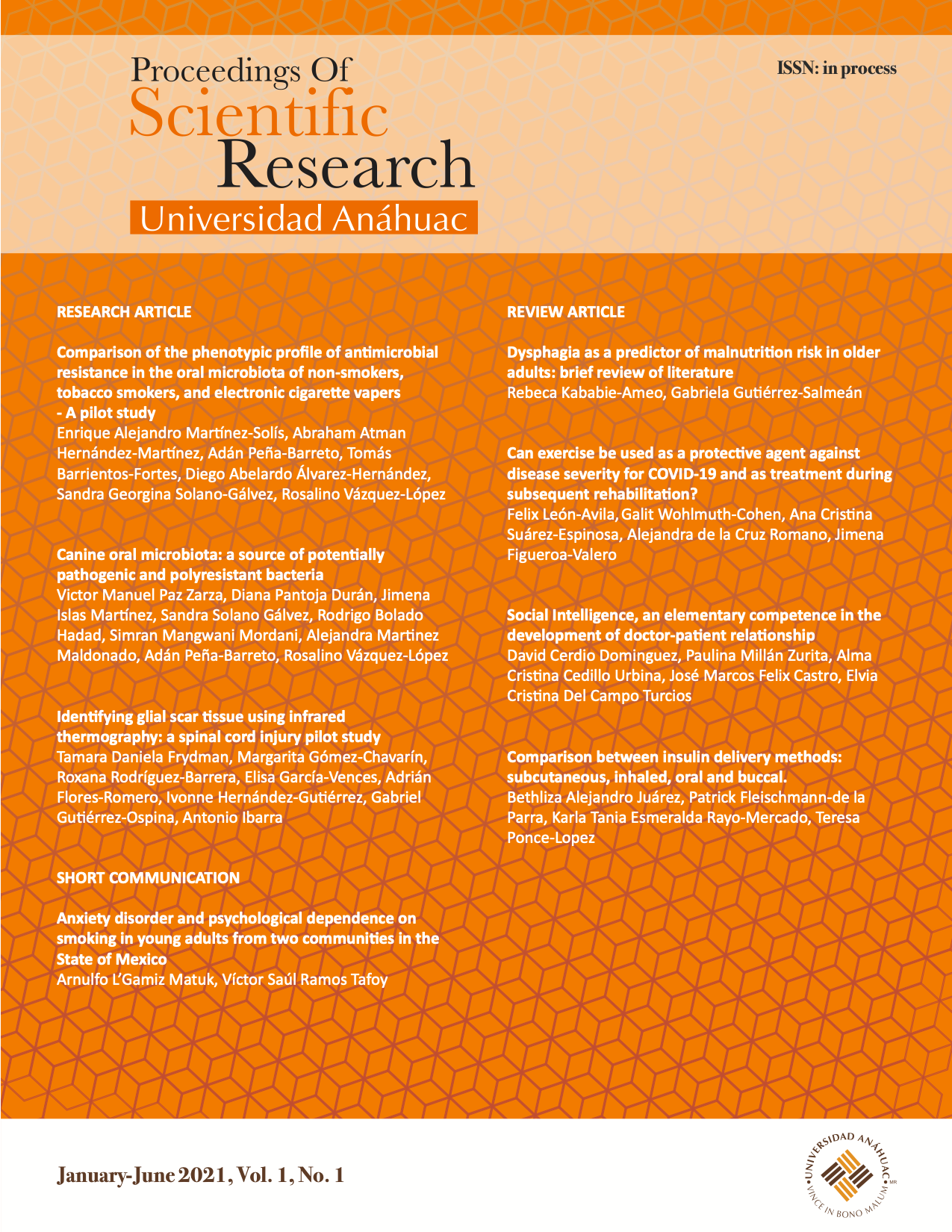Anxiety disorder and psychological dependence on smoking in adults from two communities in the State of Mexico
DOI:
https://doi.org/10.36105/psrua.2021v1n1.04Keywords:
lesión de médula espinal, termografía infrarroja, cicatriz glialAbstract
Introduction: Smoking is a public health problem associated with chronic degenerative diseases. The coexistence of tobacco consumption and anxiety disorders was detected, which represent the most frequent psychiatric illnesses around the world. Objective: Analyze the prevalence of symptoms of anxiety and their severity as a consequence of tobacco dependence in young adults from two communities in the State of Mexico. Material and methods: This is a descriptive, observational, and cross-sectional study. The measurement instrument was a survey consisting of the Fagerström test, the Glover-Nilsson test, and Beck anxiety inventory. Prior informed consent applied to adults aged 18–35 years from the municipalities of Huixquilucan and Atlautla, State of Mexico with a calculated sample of 300 subjects. The analysis was carried out using SPSS Statistics, with a significance level of α = 0.05. Results: 50.2% of the population were active smokers and 15.8% showed high suspicion of anxiety disorders independent of smoking. In smokers, 15.1% had scores for an anxiety disorder while more than 60% showed mild anxiety symptoms and 18.9%, moderate anxiety. A high prevalence of moderate dependence on nicotine was found in those smokers whose age of initiation of consumption was 16–19 years and who also had previous failure to abandon consumption. Conclusion: Anxious symptoms were found in 66% of those surveyed. This is relevant since mental illnesses have shown a significant increase, generating long-term problems in the overall health of adults.
Downloads
PLUMX metrics
References
2. Markou A. Neurobiology of nicotine dependence. Phil Trans. R. Soc. B., 2008;(363):1159-68. https://doi.org/10.1098/rstb.2008.0095
3. Guía de Práctica Clínica. Diagnóstico y Tratamiento de Trastornos de Ansiedad en el Adulto. México, Secretaria de Salud. 2010.
4. Valdés-Salgado R, Meneses-González F, Lazcano-Ponce EC, Hernández-Ramos MI, Hernández-Ávila M. Encuesta sobre Tabaquismo en Jóvenes 2009. Cuernavaca: Instituto Nacional de Salud Pública, 2010.
5. Secretaria de Salud. Encuesta Nacional de Adicciones. México, Comisión Nacional de Adicciones. 2011;65-76.
6. Guía de Práctica Clínica. Guía Rápida de Manejo y Tratamiento de Trastornos de Ansiedad en el Adulto. México, Secretaria de Salud. 2010.
7. Volkow, Koob, McLellan. Neurobiologic advances on the disease brain model of Addiction. NEJM. 2016;(374):363-71. https://doi.org/10.1056/NEJMra1511480
8. Davis B, Grier S. A tale of two urbanicities: Adolescent alcohol and cigarette consumption in high and low-poverty urban neighborhoods. Journal of Business Research. 2015;68(10):2109-2116. https://doi.org/10.1016/j.jbusres.2015.03.009
9. Joannie Lortet-Tieulent, Elisenda Renteria, Linda Sharp, Elisabete Weiderpass, Harry Comber, Paul Baas, Freddie Bray, Jan Willem Coebergh, Isabelle Soerjomataram. Eur J Cancer. 2015;51(9):1144–1163. https://doi.org/10.1016/j.ejca.2013.10.014
10. Leventhal AM, Zvolensky MJ. Anxiety, depression, and cigarette smoking: A transdiagnostic vulnerability framework to understanding emotion–smoking comorbidity. Psychol Bull. 2015;141(1):176-212. https://doi.org/10.1037/bul0000003
11. Chaiton, Michael, et al. Confounders or intermediate variables? Testing mechanisms for the relationship between depression and smoking in a longitudinal cohort study. Addictive Behav. 2015;(42):154-61. https://doi.org/10.1016/j.addbeh.2014.11.026
12. Dierker, L., Rose, J., Selya, A., Piasecki, T. M., Hedeker, D., & Mermelstein, R. Depression and nicotine dependence from adolescence to young adulthood. Addictive Behav. 2015;(41):124-28. https://doi.org/10.1016/j.addbeh.2014.10.004
13. Dierker, L., Hedeker, D., Rose, J., Selya, A., & Mermelstein, R. Early emerging nicotine dependence symptoms in adolescence predict daily smoking in young adulthood. Drug and alcohol Dep. 2015;(151):267-71. https://doi.org/10.1016/j.drugalcdep.2015.03.009
14. Olvera, H., Bakhshaie, J., Garey, L., Jardin, C., Schmidt & Zvolensky, M. J. The Role of Anxiety Sensitivity in the Relation between Trait Worry and Smoking Behavior. Nicotine & Tobacco Res. 2015;(17):682-89. https://doi.org/10.1093/ntr/ntu233
Downloads
Additional Files
Published
How to Cite
Issue
Section
License
Copyright (c) 2021 Arnulfo L’Gamiz Matuk, Víctor Saúl Ramos Tafoya

This work is licensed under a Creative Commons Attribution-NonCommercial-NoDerivatives 4.0 International License.
All the intellectual content found in this publication is licensed to the consumer public under the figure of Creative Commons©, unless the author of said content has agreed otherwise or limited said faculty to "Proceedings of Scientific Research Universidad Anáhuac. Multidisciplinary Journal of Healthcare©" or "Universidad Anáhuac Mexico©" in writing and expressly.
Proceedings of Scientific Research Universidad Anáhuac. Multidisciplinary Journal of Healthcare is distributed under a Creative Commons Attribution-NonCommercial-NoDerivatives 4.0 International License.
The author retains the economic rights without restrictions and guarantees the journal the right to be the first publication of the work. The author is free to publish his article in any other medium, such as an institutional repository.













